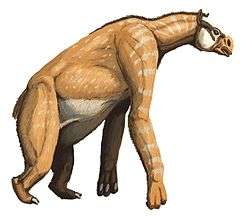Chalicotheriinae
Chalicotheriines make up an extinct subfamily of the family Chalicotheriidae, a group of herbivorous, odd-toed ungulate (perissodactyl) mammals. Characteristics of this group included a horse-like long head, very long forelimbs, short hindlimbs, a partial knuckle-walking position and a relatively gorilla-like physique. Members of this subfamily were regarded as possessing one of the longest forelimbs and shortest hindlimbs in relation to each other out of all extinct animals. Analysis of dental wear implies most chalicotheriines fed on seeds and fruit. Their claws were most likely used in a hook-like manner to pull down branches, suggesting they lived as bipedal browsers. Presence of chalicotheriine fossils is generally regarded as an indicator of treed environments.[1]
| Chalicotheriinae | |
|---|---|
 | |
| Anisodon grande, formerly Chalicotherium grande | |
| Scientific classification | |
| Kingdom: | |
| Phylum: | |
| Class: | |
| Order: | |
| Suborder: | |
| Superfamily: | |
| Family: | |
| Subfamily: | †Chalicotheriinae Holland and Peterson, 1914 |
| Genera | |
| |
References
- Coombs, Margery C. (13 Feb 2009). "The chalicothere Metaschizotherium bavaricum (Perissodactyla, Chalicotheriidae, Schizotheriinae) from the Miocene (MN5) Lagerstatte of Sandelzhausen (Germany): description, comparison, and paleoecological significance". Paläontologische Zeitschrift. Springer Berlin / Heidelberg. 83 (1): 85–129. doi:10.1007/s12542-009-0004-x.